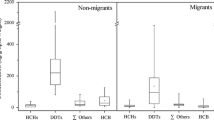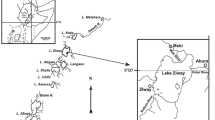Abstract
The residues of persistent organochlorinated pollutants (POPs), namely polychlorinated biphenyls (PCBs) and organochlorine pesticides (OCPs) (HCHs, CHLs, HCCPs, DDTs, and dicofol congeners) were investigated in the hair and muscle of road-killed Erinaceus roumanicus and E. concolor in Turkey. Mean residue levels were as follows: in hair, PCBs = 7.43 ± 4.88 ng/g and OCPs = 9.21 ± 1.27 ng/g; in muscle, PCBs = 30.73 ± 2.51 ng/g and OCPs = 145.04 ± 16.59 ng/g. There was no significant difference between species and sex, while there was significant difference between habitats and regions in terms of either total PCB and OCP levels, or POP levels (p < 0.05). Age was a determinative factor for the bio-accumulation of POPs. The contaminant levels were high in the species, sample areas, and habitats. The data also showed that tissues of hedgehogs are suitable for monitoring and evaluating the bioaccumulation of POP levels in Turkey.





Similar content being viewed by others
References
Aichner B, Glaser B, Zech W (2007) Polycyclic aromatic hydrocarbons and polychlorinated biphenyls in urban soils from Kathmandu, Nepal. Org Geochem 38:700–715
Alleva E, Francia N, Pandolfi M, De Marinis AM, Chiarotti F, Santucci D (2006) Organochlorine and heavy-metal contaminants in wild mammals and birds of Urbino-Pesaro province, Italy: an analytic overview for potential bioindicators. Arch Environ Contam Toxicol 51:123–134
Alomar H, Lemarchand C, Rosoux R, Vey D, Berny P (2016) Concentrations of organochlorine compounds (pesticides and PCBs), trace elements (Pb, Cd, Cu, and Hg), 134Cs, and 137Cs in the livers of the European otter (Lutra lutra), great cormorant (Phalacrocorax carbo), and European catfish (Silurus glanis), collected from the Loire River (France). Eur J Wildl Res 62:653–661
Anastassiades M, Lehotay SJ, Štajnbaher D, Schenck FJ (2003) Fast and easy multiresidue method employing acetonitrile extraction/partitioning and “dispersive solid-phase extraction” for the determination of pesticide residues in produce. J AOAC Int 86:412–431
Ayas Z, Barlas NE, Kolankaya D (1997) Determination of organochlorine pesticide residues in various environments and organisms in Göksu Delta, Turkey. Aquat Toxicol 39:171–181
Batt AL, Wathen JB, Lazorchak JM, Olsen AR, Kincaid TM (2017) Statistical survey of persistent organic pollutants: risk estimations to humans and wildlife through consumption of fish from US rivers. Environ Sci Technol 51:3021–3031
Bergman Å, Rydén A, Law RJ, de Boer J, Covaci A, Alaee M, Van den Eede N (2012) A novel abbreviation standard for organobromine, organochlorine and organophosphorus flame retardants and some characteristics of the chemicals. Environ Int 49:57–82
Best SM (1973) Some organochlorine pesticide residues in wildlife of the Northern Territory, Australia, 1970-71. Aust J Biol Sci 26:1161–1170
Bondy G, Armstrong C, Coady L, Doucet J, Robertson P, Feeley M, Barker M (2003) Toxicity of the chlordane metabolite oxychlordane in female rats: clinical and histopathological changes. Food Chem Toxicol 41:291–301
Bustnes JO, Folstad I, Erikstad KE, Fjeld M, Miland OO, Skaare JU (2002) Blood concentration of organochlorine pollutants and wing feather asymmetry in glaucous gulls. Funct Ecol 16:617–622
Chou SF, Griffin RA (1983) Soil, clay, and caustic soda effects on solubility, sorption, and mobility of hexachlorocyclopentadiene. Illinois State Geological Survey Division, U.S. Department of Commerce, Champaign, PB84-P116060
Clark DR Jr (1990) Dicofol (Kelthane) as an environmental contaminant: a review (No. 29). US Fish and Wildlife Service, Washington, DC
Coelhan M, Strohmeier J, Barlas H (2006) Organochlorine levels in edible fish from the Marmara Sea, Turkey. Environ Int 32:775–780
Covaci A, Schepens P (2001) Chromatographic aspects of the analysis of selected persistent organochlorine pollutants in human hair. Chromatographia 53:366–371
D’Havé H, Scheirs J, Covaci A, Schepens P, Verhagen R, De Coen W (2006a) Nondestructive pollution exposure assessment in the European hedgehog (Erinaceus europaeus): III. Hair as an indicator of endogenous organochlorine compound concentrations. Environ Toxicol Chem 25:158–167
D’Havé H, Scheirs J, Mubiana VK, Verhagen R, Blust R, De Coen W (2006b) Non-destructive pollution exposure assessment in the European hedgehog (Erinaceus europaeus): II. Hair and spines as indicators of endogenous metal and As concentrations. Environ Pollut 142:438–448
DeVito MJ, Birnbaum LS, Farland WH, Gasiewicz TA (1995) Comparisons of estimated human body burdens of dioxinlike chemicals and TCDD body burdens in experimentally exposed animals. Environ Health Perspect 103:820
Domingo JL (1994) Metal-induced developmental toxicity in mammals: A review. J Toxicol Environ Health A 42:123–141
Fisk AT, Hobson KA, Norstrom RJ (2001) Influence of chemical and biological factors on trophic transfer of persistent organic pollutants in the Northwater Polynya marine food web. Environ Sci Technol 35:732–738
Fowler BA (1992) Mechanisms of kidney cell injury from metals. Environ Health Perspect 100:57
Hagen PE, Walls MP (2005) The Stockholm Convention on persistent organic pollutants. Nat Resour Environ 19:49–52
Harding LE, Harris ML, Stephen CR, Elliott JE (1999) Reproductive and morphological condition of wild mink (Mustela vison) and river otters (Lutra canadensis) in relation to chlorinated hydrocarbon contamination. Environ Health Perspect 107:141–147
Harner T, Shoeib M, Diamond M, Stern G, Rosenberg B (2004) Using passive air samplers to assess urban-rural trends for persistent organic pollutants. 1. Polychlorinated biphenyls and organochlorine pesticides. Environ Sci Technol 38:4474–4483
Henny CJ, Kaiser JL, Grove RA, Johnson BL, Letcher RJ (2009) Polybrominated diphenyl ether flame retardants in eggs may reduce reproductive success of ospreys in Oregon and Washington. USA Ecotoxicol 18:802–813
Holoubek I, Dušek L, Sáňka M, Hofman J, Čupr P, Jarkovský J, Zbíral J, Klánová J (2009) Soil burdens of persistent organic pollutants - their levels, fate and risk. Part I. Variation of concentration ranges according to different soil uses and locations. Environ Pollut 157:3207–3217
Hoshi H, Minamoto N, Iwata H, Shiraki K, Tatsukawa R, Tanabe S, Kinjo T (1998) Organochlorine pesticides and polychlorinated biphenyl congeners in wild terrestrial mammals and birds from Chubu region, Japan: interspecies comparison of the residue levels and compositions. Chemosphere 36:3211–3221
Huang T, Guo Q, Tian H, Mao X, Ding Z, Zhang G, Li J, Ma J, Gao H (2014) Assessing spatial distribution, sources, and human health risk of organochlorine pesticide residues in the soils of arid and semiarid areas of northwest China. Environ Sci Pollut Res 21:6124–6135
Huijser MP (1999) Human impact oil populations of hedgehogs Erinaceus europaeus through traffic and changes in the landscape. Lutra 42:39–56
Hutterer R (2005) Order Erinaceomorpha. In: Wilson DE, Reeder DM (eds) Mammal species of the world: a taxonomic and geographic reference. The Johns Hopkins University Press, Baltimore, pp 212–219
Johnson MS, Leah RT, Connor L, Rae C, Saunders S (1996) Polychlorinated biphenyls in small mammals from contaminated landfill sites. Environ Pollut 92:185–191
Jones KC, De Voogt P (1999) Persistent organic pollutants (POPs): state of the science. Environ Pollut 100:209–221
Kalyoncu L, Agca I, Aktumsek A (2009) Some organochlorine pesticide residues in fish species in Konya, Turkey. Chemosphere 74:885–889
Kamrin MA, Ringer RK (1996) Toxicological implications of PCB residues in mammals. Heavy metals in the marine environment. CRC Press, Boca Raton, pp 153–164
Kocagöz R, Onmuş O, Onat İ, Çağdaş B, Sıkı M, Orhan H (2014) Environmental and biological monitoring of persistent organic pollutants in waterbirds by non-invasive versus invasive sampling. Toxicol Lett 230:208–217
Kolankaya D (2006) Organochlorine pesticide reidues and their toxic effects on the environment and organisms in Turkey. Int J Environ Anal Chem 86:147–160
Lazartigues A, Wiest L, Baudot R, Thomas M, Feidt C, Cren-Olivé C (2011) Multiresidue method to quantify pesticides in fish muscle by QuEChERS-based extraction and LC-MS/MS. Anal Bioanal Chem 400:2185–2193
Mason CF, O’sullivan WM (1992) Organochlorine pesticide residues and PCBs in otters (Lutra lutra) from Ireland. Bull Environ Contam Toxicol 48:387–393
Mathias MDL, Graca C, Ferreira AM, Duarte-Rodrigues P (2007) Residues of DDT and other organochlorines in small mammals from Central Portugal. Mammalia 71:83–85
Newton I (1979) Population ecology of raptors. Harrell Books, England
Okay OS, Karacık B, Başak S, Henkelmann B, Bernhöft S, Schramm KW (2009) PCB and PCDD/F in sediments and mussels of the Istanbul strait (Turkey). Chemosphere 76:159–166
Ottolenghi AD, Haseman JK, Suggs F (1974) Teratogenic effects of aldrin, dieldrin, and endrin in hamsters and mice. Teratol 9:11–16
Rautio A, Kunnasranta M, Valtonen A, Ikonen M, Hyvärinen H, Holopainen IJ, Kukkonen JV (2010) Sex, age, and tissue specific accumulation of eight metals, arsenic, and selenium in the European hedgehog (Erinaceus europaeus). Arch Environ Contam Toxicol 59:642–651
Reeve N, Lindsay R, (1994) Hedgehogs T & AD Poyser, London
Sapozhnikova Y, Lehotay SJ (2013) Multi-class, multi-residue analysis of pesticides, polychlorinated biphenyls, polycyclic aromatic hydrocarbons, polybrominated diphenyl ethers and novel flame retardants in fish using fast, low-pressure gas chromatography–tandem mass spectrometry. Anal Chim Acta 758:80–92
Schenck FJ, Hobbs JE (2004) Evaluation of the quick, easy, cheap, effective, rugged, and safe (QuEChERS) approach to pesticide residue analysis. Bull Environ Contam Toxicol 73:24–30
Schramm KW (2008) Hair-biomonitoring of organic pollutants. Chemosphere 72:1103–1111
Shore RF, Casulli A, Bologov V, Wienburg CL, Afsar A, Toyne P, Dell′Omo G (2001) Organochlorine pesticide, polychlorinated biphenyl and heavy metal concentrations in wolves (Canis lupus L. 1758) from north-west Russia. Sci Total Environ 280:45–54
Vermeulen F, D’Havé H, Mubiana VK, Van den Brink NW, Blust R, Bervoets L, De Coen W (2009) Relevance of hair and spines of the European hedgehog (Erinaceus europaeus) as biomonitoring tissues for arsenic and metals in relation to blood. Sci Total Environ 407:1775–1783
Vermeulen F, Covaci A, D’Havé H, Van den Brink NW, Blust R, De Coen W, Bervoets L (2010) Accumulation of background levels of persistent organochlorine and organobromine pollutants through the soil–earthworm–hedgehog food chain. Environ Int 36:721–727
Acknowledgements
We would like to express our gratitude to Dr. Oner Koçak, the founder of Hacettepe University Pesticide Research and Reference Laboratory, who has provided his full support to us throughout the study and contributed greatly to its completion.
Author information
Authors and Affiliations
Corresponding author
Rights and permissions
About this article
Cite this article
Arıkan, K., Arıkan, Z.Y. & Turan, S.L. Persistent Organochlorine Contaminant Residues in Tissues of Hedgehogs from Turkey. Bull Environ Contam Toxicol 100, 361–368 (2018). https://doi.org/10.1007/s00128-018-2272-1
Received:
Accepted:
Published:
Issue Date:
DOI: https://doi.org/10.1007/s00128-018-2272-1




